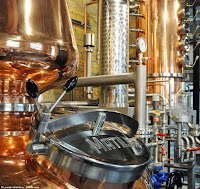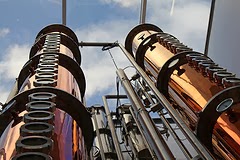As we roll comfortably into spring, it seems that the major players in the world of whisky are moving forward with their big ticket items, as the yearly release schedule gets firmly under way. Only two weeks ago, Suntory unveiled their mighty new No Age Statement
Distiller's ReserveYamazaki and
Hakushu expressions. Now, hot on their heels, comes arguably the most widely anticipated release so far: the reemergence of
Mortlach.
![]()
So far, the news of four new Mortlach bottlings has not gone down well with one particular camp.
The withdrawal of the Flora & Fauna 16 year old (which, according to Diageo, was sitting at around 800 cases per year, so a tiny outturn indeed) ruffled a few feathers with a small-but-vocal core of whisky enthusiasts and fanatics. The announcement of two No Age Statement releases (Rare Old, a name which has been particularly prickly for many and a Special Strength version (the same liquid but bottled at 49%) alongside a brace of older, super premium expressions (18 and 25 year old) did little to help stem the negativity about the releases, which are scheduled for June/July this year.
But far from throw our miniatures out the pram and take to Twitter like it was a modern day pitch fork, we looked at the plan objectively. Mortlach is currently undergoing something of a major transformation from an under-appreciated distillery many whisky drinkers simply know nothing about - to a major player in the luxury market, which spans global proportions. Capacity is being doubled from an existing 3.8 million litres, with six new stills being installed - complete with worm tub condensers: probably the first time since the 1980's that any distillery of note (save for smaller, more craft orientated operations) has gone down this route.
There are clear similarities with a certain distillery beginning with M and ending in acallan. Limited stock and a rising demand for a particular flavour profile internationally has meant that a rethink was necessary in terms of the type of bottling available and its pricing structure. Macallan's huge success in Asia has meant that certain expressions have been withdrawn and the stock structure has taken on an altogether more personality (and colour) led focus, without age statement.
![]() |
The new look Mortlach, when it is finished.
|
Mortlach has the opportunity to do the same and become a serious rival in the same circles as The Macallan. It has a bold, European oak dominated character and given proper investment and careful stock selection, Diageo can promote the brand into the luxury league.
But this can only happen if the new liquid is any good. Despite the best efforts of anyone, there will always be those who fervently criticise the decision to withdraw the 16 year old, resenting the progress of the brand into the major-league.
To use an analogy from the world of music, it's a little like when Dylan went 'electric' back in 1965. 'Judas!' cried one hessian-clad misery guts. 'He's sold out,' cried another be-sandaled folkie, the full horror etched for all to see on his patchily bearded face, as Dylan tore through 'Like a Rolling Stone', backed with a new set of amped up, electrified musicians.
The reason for their protestation? Arguably because they had lost control of something they thought they had all to themselves.
Dylan's canon of music is of course a milestone in the Great American Songbook and his solo performances will always stand the test of time. But without his reinvention, his popularity would have swiftly reached a plateau. Probably fine for his many folk followers, but for a man of clear ambition, success needs progress - and progress requires decisions - many of them hard to swallow for those who felt They Woz There from the beginning.
Of course, Mortlach is a distillery, effectively owned by shareholders; a commercial distilling enterprise, not a visionary (if slightly frazzled) American singer songwriter. So the changes Diageo are implementing for the brand make a great deal of sense from a business point of view. By creating a range of whiskies, each with an escalating price point and age, alongside a bottle design with a greater degree of craftsmanship (they are quite stunning close up)- the halo effect comes into play, rather the same as it does in the Johnnie Walker range.
But for the principle to work and for the halo to become fully (and angelically) illuminated, the liquid needs to be a fine piece of work at every price point, especially given that the releases are bottled into 50cl sized vessels (75cl for the US)
So is it?
Well, today, we got the chance to find out, thanks to a presentation from one of its main creators, Dr Matthew Crow and Mortlach's newly appointed ambassador, Georgie Bell. After trying the new make spirit (which was about as bold and malty as any we have come across) it was time to visit the range for the very first time.
Time to turn up the volume and hit play on Blonde On Blonde?
Or simply skulk off to an inoffensive, grumpy solo acoustic version of The Times They Are a-Changin?
Mortlach - Rare Old - No Age Statement - 43.4% - 50cl - RRP £55
Nose: A big hit of bold copper aroma, woody spice, rich caramel sauce, Creme Brûlée and a little charred meat. It perhaps doesn't have the full on 'meatiness' that the Mortlach of old has become renowned for, but anyone approaching this from afresh, will find a plenty of meat on the bone - the spices are very well integrated, alongside a sweeter vanilla note too.
Palate: The charred meat continues, with swathes of robust caramel sauce, tobacco, dark chocolate and a touch of orchard fruit. With a little water, the orchard fruit comes to the front and the creamy vanillas start to take hold. A dram of two halves, that's for sure.
Finish: An oaky dryness, with a lingering and very mature spice note.
Overall: It's Mortlach.... That's right folks, it's Mortlach. Nothing really taken away and nothing unnecessary added either. Solid, warming and very robust, just like it should be. The cask choice here is very complimentary and the refill hoggies balance nicely with a little re-charred spice, alongside a drop of European oak richness. A great start.
Next up - The Special Strength version, released specifically for Global Travel Retail outlets. This is effectively the same formulation as the Rare Old, but weighs in at 49%. Will the slightly higher ABV make much of a difference?
Mortlach - Special Strength Edition - No Age Statement - 49% - 50cl - RRP £75
Nose: Wow, a real surprise. Fresh blueberries, toasted vanilla, burnt caramel, milky coffee and a much more intense copper coin note. Vintage aromas at work? In fact, open a bottle of 'Old' whisky, i.e. one bottled a long time ago and this shares a number of similarities. Given time, a sticky gingerbread pudding note develops alongside the more familiar charred wood/meat aroma.
Palate: The extra strength gives this a much more defined and direct mouthfeel, with scorched orange zest, blueberries, a very fatty nuttiness and a hint of menthol. Water brings through a light blackberry note, alongside a slate/flinty note.
Finish: Dry tobacco and dark chocolate.
Overall: The sceptic in me would look at this release as a bit of a cash cow, but in total fairness, this is a very different whisky to the Rare Old, despite sharing its DNA. The extra strength gives it a fundamentally different personality altogether and one which I very much enjoyed. A whisky that will keep delivering in many different ways, whenever you go back to it.
Next up, the 18 year old, which Matthew informs us has a greater proportion of first-fill European oak, balanced with refill barrels and butts. Clearly, the 16 year old will be a reference point, but by how much?
Mortlach - 18 Year Old - 43.4% - 50cl - RRP £180
Nose: You're straight into a very robust mix of wet mossy leaves, gingerbread, spiced dried fruits, some earthy tobacco, dark chocolate and orange zest. Given time, a more fragrant rose note begins to develop (rather like Turkish Delight) and a lighter coffee aroma. Superb.
Palate: The bold-as-brass approach continues to the palate, but with some very well balanced complexity in tow: more of the dried fruits, a return of the charred meat, malty dark chocolate, Cognac steeped oranges and then sweet vanilla. Water brings a welcome return of the orchard fruit and then a more milky/creamy coffee note.
Finish: Dry, with more dark chocolate and oaky spice.
Overall: A different liquid to the 16 year old, with greater subtlety and integration of the bold flavours you would hope for. This is sensational stuff, make no mistake.
To finish - the 25 year old. Priced against the Macallan expression of the same age (around £600) this is clearly aimed squarely at the same type of high end drinker. A significant price uplift on where the 18 year old fits, so one would expect this to really deliver. The profile is taken solely from refill American oak casks too... Curious...
Mortlach - 25 Year Old - 43.4% - 50cl - RRP £600
Nose: Hard to put an age on this, but if we were pinned to the wall, we would say it has aromas associated with far older whiskies: highly polished leather, mahogany tables, toasted chestnuts, then into a heady mix of sandalwood, cedar and scented wax. Give this more time to open up and you're suddenly in tropical fruit heaven: custard topped mango, with a little dusting of soot, followed by more of the Turkish Delight from the 18 year old. Effortless ageing - peerless aromas.
Palate: A continuation of the fragrant wax, backed with salted caramel, light tropical fruits, Portuguese custard tart, and a hidden nuttiness (chestnuts again). Given more time, the complexity develops further with a wonderful integrated spiced oak, sitting alongside the creamy custard. Nothing is out of place, or too dominant - it all sits together rather brilliantly.
Finish: Lengthy notes of creamy oak, some lighter fragranced wood and a more gentle spice, tempered by a sweet vanilla.
Overall: This is something to sit with, ponder over and try to get to the bottom of. It is without doubt, one of the best new releases to come from Diageo in some time (alongside the Special Release Convalmore of last year.) At £600, anything less would be considered as a huge disappointment, but hats off, as this delivers on every level.
So there you have it. A brand new core range has arrived. Dylan has officially picked up his Stratocaster. The ticket price and volume have gone up accordingly and the venues are getting more far flung and exotic - but the show has become far more engaging.
Those who don't want to go along for the ride, remember the old times, start stashing away the
bootlegs and tell everyone you were there at the start...And if you still don't like what you're hearing, there's always
Woody 'Dailuaine' Guthrie. He's not due for a reinvention any time soon, as far as we can see...













































































